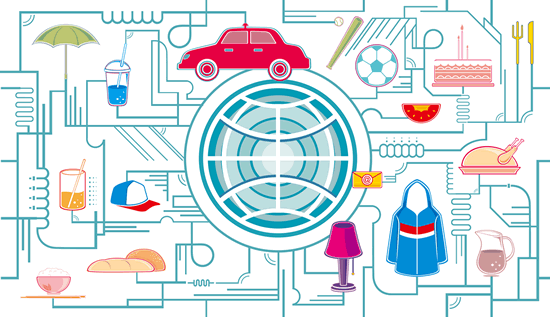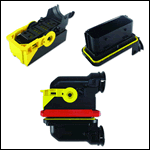Automotive Meets IoT in the Connected Car
With pervasive connectivity, powerful features emerge that change the entire automotive ecosystem in the connected car.

In recent years, in-car systems have been supplemented by basic Internet connectivity, allowing drivers and passengers to remain “plugged in” to the business and social networks they take for granted when at home or in the office. But what if connectivity could be taken a stage further? What if the most modest sensor or even the engine management unit could send and receive information without the involvement of the driver? With pervasive connectivity, powerful new features are emerging that will not only change the driving experience, but will dramatically change the entire automotive ecosystem. This vehicle already has a name – the “connected car.”
Safety Benefits
It has been estimated that by 2017 more than 60% of the world’s vehicles will be connected to monitor the safety and security of vehicles and occupants. By then, all new cars are expected to have built-in technology that will allow them to automatically call emergency services if the worst happens. The vehicle will have the intelligence to provide its location to emergency services as well as convey vital information.
Of course, one of the primary goals of the connected car is to avoid dangerous situations in the first place. In a recent 15-month study of 2,800 vehicles equipped with a swarm of sensors monitoring everything from road conditions, distance to the vehicle in front, vehicle speed and acceleration, and location (via GPS) together with wireless vehicle-to-vehicle communications technology, around 400 vehicles recorded and warned of an impending crash that was avoided. The ability to monitor other vehicles and provide this type of feedback to the driver goes far beyond the familiar back-up camera or vehicle blind-spot sensor.
Though not directly related to actual driving, another potentially huge benefit of the connected automobile is related to insurance. Today, automobile insurance companies base their premiums on demographics – a driver’s age, gender, home location, and driving history all factor into the amount paid for insurance. Using uploaded data from on-board vehicle telematics systems (the collective term for the network of sensors and processors), insurers will soon be able to match premiums with true risk based upon measured variables such as driving location and actual driving behavior. Similar data will also be gathered by municipalities and used to assess taxes and fees rather than using the fuel excise tax of today.
Standards and Specifications
The European Union (EU) has taken a leading role in moving the connected car from concept to reality. Earlier this year the EU announced that two European standards organizations, the European Telecommunication Standard Institute (ETSI) and the European Committee for Standardization (Comité Européen de Normalisation or CEN) confirmed that the basic set of standards to make connected cars a reality has been fully completed. These standards ensure that vehicles made by different manufacturers will be able to communicate with each other.
At first glance, the inside of the connected car won’t appear too different from today’s vehicles. A large human-machine interface will likely dominate the dash similar to those in current vehicles. Though a modern car already contains networks formed from wired and wireless elements, much of that technology will need to be adapted and upgraded to suit connection to the Internet of Things. Electronic control units (ECUs) – modules that control everything from dashboard instruments to safety features, powertrain components to in-vehicle infotainment (IVI) systems – use wired Controller Area Network (CAN) or Local Interconnect Network (LIN) buses. However, the number of these devices in the average car has steadily increased in the past 10 years, and many vehicles now incorporate more than 200 separate ECUs.
New Technology
Changes to this conventional layout are likely to include the use of high-speed Ethernet to replace older, slower CAN and LIN buses to link the various systems and the introduction of mini hubs to aggregate groups of sensors or ECUs to allow communication to servers in the cloud directly. Wireless connectivity such as Bluetooth technology or Wi-Fi is typically used to connect smartphones and tablets to the vehicle’s dash-mounted HMI. Everything will still connect back to a central-vehicle gateway that will retain the on-board diagnostics data link connector (OBD DLC), but vehicles will also incorporate a telemetry module to look after the wireless connectivity to the Internet. A good way to consider a vehicle’s IoT connectivity is to consider the car as a large hub to which all the systems and subsystems of the vehicle link in order to send and receive information to the wider network.
Electronics manufacturers such as Texas Instruments, Amphenol, and Analog Devices have long considered the automotive segment as a top priority and are making IoT technology available through a variety of components, evaluation kits, and software. But these are early days for the technology and automotive-grade components are thin on the ground.
The connected car promises to improve the driving experience, save lives, and transform the industry. However, in order to fully unlock this potential, a wide range of barriers needs to be addressed, including security, safety, regulation, and privacy. So while the future for the connected car is undoubtedly bright, the highway to its success is covered with speed bumps.
Learn more about the connected car on Mouser’s automotive website.
Author Warren Mill, of Mouser Electronics, has more than 30 years of experience in electronics. He’s held a variety of positions in engineering, applications, strategic marketing, and product planning with large electronics companies like Advanced Micro Devices, Actel, and Avnet, as well as with a variety of smaller startups. He has in-depth experience with programmable devices (PLDs, FPGAs, MCUs, and ASICs) in industrial, networking, and consumer applications and holds several device patents.





